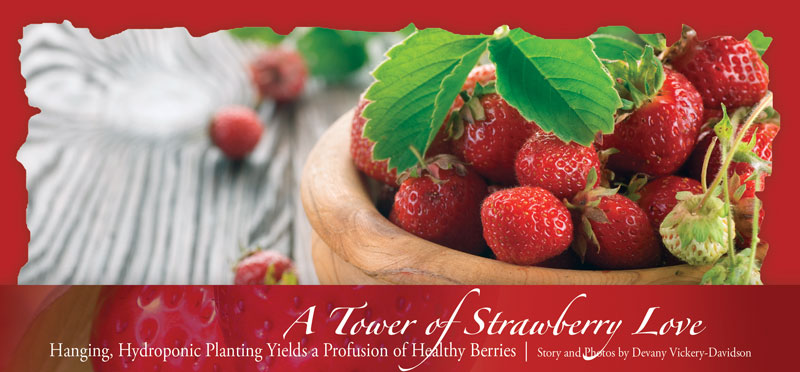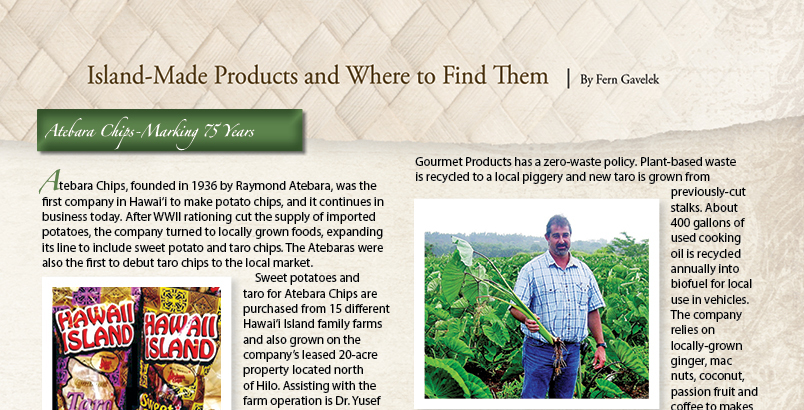
A Tower of Strawberry Love: Hanging, Hydroponic Planting Yields a Profusion of Healthy Berries

By Devany Vickery-Davidson
Hawai‘i Island draws many Alaskans to her shores. There must be something about the lure of the tropics and year-round growing season especially appealing to hopeful farmers from the northern reaches of the United States. One of those former Alaskans came here with a dream of growing strawberries year-round.
Jim Riley was in the construction business in Soldotna, Alaska, when he decided to make his way to the warm climate of Hawai‘i Island to realize his dream, and Mountain View Growers was born.
After years of research on hydroponics and the variety of ways to grow strawberries and other produce, he decided on a unique tower system. Vertical growing not only assures ease of picking and takes minimal land area, but also allows the trailing berries to be planted in intensive masses and well above the ground where pests such as slugs and snails often like to dine. This system is widely used in Florida where Epcot first showcased it in “The Land” pavilion.
Mountain View is on the slopes of Mauna Loa, where the 1,440-foot elevation suits many crops—coffee, citrus and tropical fruit such as longan and rambutan among them. Mountain Strawberries like the slightly cooler weather in East Hawai‘i, and Mountain View Farms was the first farm to grow strawberries there. It remains only one of a handful of farms on Hawai‘i’s Big Island growing strawberries year round.
Jim started by clearing the front acre of his land and building greenhouses. Not your typical enclosed greenhouse, these have no walls, to maximize airflow and reduce the chance of fungus and mildew. The huge, transparent roofs of the greenhouses allow light and catch rainwater that flows into the catchment tank—their only source of water. Mountain View averages 136 inches of rain annually.
In a few months, Jim and his friend Royall Clark constructed the greenhouses, installed the irrigation/feeding system and set up the unique, Styrofoam towers for planting. Every tower is set in a larger pot with a feeding tube that goes through the center. The bottom pots are used for plants other than strawberries: collards, fennel, carrots, peppers, kale and chives, among other vegetables, thrive under the strawberries. A planting medium made of coconut husks and vermiculite allows the plant nutrients to flow through the system at intervals, maintaining the perfect balance needed for optimum growth. Once the towers were ready and filled with the planting medium, a bevy of friends pitched in to help plant tens of thousands of bare-root strawberry plants in barn-raising style.
Within just a few weeks, the first harvest of berries was ready for picking. The picking never seems to stop. With the perfect combination of light, temperature, and a specially designed, all-natural plant nutrient, succulent strawberries are thriving in Mountain View. Residents of East Hawai‘i are treated to fresh, local strawberries from the farm all year round. Local restaurants also feature Mountain View berries on their menus. Two types of berries grow there: one is a large, bright berry that can be used for dipping and decorating. The other is a smaller and sweeter berry that works perfectly for strawberry shortcakes, jams, jellies, and other strawberry treats.
Currently, the berries are picked for two farmers markets: the Wednesday Hilo Farmers Market and the very early Volcano Farmers Market on Sundays. The Volcano Market is typically sold out by 8am.
Mountain View Farm is growing several crops in addition to their beautiful berries while determining which crops are in high demand and which do best on the farm. One recent big seller has been poha berries, which are also known as Peruvian cherries, and cape gooseberries. Beautiful, heirloom tomatoes are grabbed up as fast as they are put on the market tables. Fennel and a variety of greens often sell out at the markets, so if you want something specific it is a good idea to ask them to set something aside for you. A new crop of rhubarb is almost ready for picking and customers have already lined up for the first rhubarb harvest.
Like most small, family farms, this endeavor has not come without some personal sacrifices. Jim lives in a small shack on the farm with his guard dog. A propane refrigerator, cold catchment water and a portable lua (toilet) are his only conveniences for now. Eventually he will have grander living quarters, but for the time being, he is prepared to live minimally and build his farm. He has to tend the farm every day, constantly trimming, planting, picking and packaging produce for sale. Strawberries have a reputation for being a bit fussy. His girlfriend, Cherie Moffat, a retired nurse, pitches in and helps out at the farm. She picks berries, runs the market sales and helps to select items to grow. Tired at the end of a productive day, they don’t have much of a social life. The farm does employ one part-time employee who helps to pick before market days.
Jim and Cherie are investigating some aftermarket products such as dehydrated berries, jams, jellies, frozen berries, purees and sauces, so a commercial kitchen might be in their future.
Strawberries are certainly not native to Hawai‘i, even though they are a fruit that has been around for over 2,000 years. In their early history, strawberries were known during the Christian era, and were widely spread in the Roman culture where they were used in festivals and with grapes as a food of choice.
They underwent a period of relative hiatus when the Roman Empire fell, only to reemerge during medieval times, when they were prized for their medicinal qualities more than for their culinary value.
Those ancestors of today’s strawberries were much smaller and more bitter than sweet. Around 1715, a French explorer found a new strain of strawberries growing in Chile and Peru, taking some back to be bred in France with European berries to make a larger, sweeter berry. Until advances in transportation and refrigeration, strawberries were considered an elite fruit for the very wealthy because the cost of getting them to market quickly was high.
Today, 94 percent of Americans consume strawberries at least once a year. We would be wise to eat more. Berries are more than just another pretty dessert. They contain healing phytochemicals that help ward off cancer and prevent cataracts.
Mountain View Growers does not have a website, but they can be found on Facebook. For more information about markets contact Cherie Moffat at 808.854.7704.
Chipotle, Strawberry, and Liliko‘i Jam
8 cups strawberries
1 can Chipotle Chiles in Adobo
4 cups raw organic sugar
1 cup honey
1 cup Liliko‘i juice
2 envelopes of LIQUID Pectin
Special Equipment: Canner with rack, jars, jar lifter, canning funnel and new seals.
Put jars, lids and seals in dishwasher and run on the hottest temperature. Leave in the dishwasher till you are ready to use. If you don’t want to to this, wash all items and then place in a pot of boiling water for 5 minutes and leave in the hot water till you are ready to use them.
Process chiles, liliko‘i, and berries in a food processor, being careful not to over process, you want some pieces of berry. Makes 12 pint jars of jam.
Pour berry mixture, sugar and honey into a large pot. Cook, stirring frequently till mixture comes to a boil. Add the liquid pectin and cook for another 5 minutes.
Immediately pour the hot jam into hot jars and put the lids on. Once you have completed this, put the jars into a canner with warm water and bring to a boil for 10 minutes. Remove and cool.
Once the jam is completely cool it will solidify. If you want to use it as a glaze, just heat it up in a small pan. This is also great served over cream cheese or marscapone.


